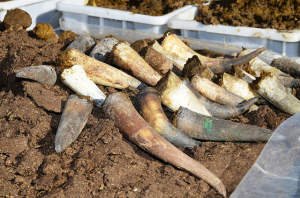As we’ve covered several times on The Academic Wino, organic and biodynamic viticulture and winemaking methods are on the rise, often with the goal of becoming a more sustainable industry and an industry that is kind to the environment and to human health.
There are several differences between organic and biodynamic viticulture, but probably the biggest difference relates to the use of fermented “preparations” in biodynamic vineyard management protocols. Specifically, these preparations supposedly improve the soil-nutrient cycle, photosynthesis, compostability,
energy efficiency, and soil and crop quality.
Physiologically and chemically, biodynamic preparations in vineyards are said to improve overall “balance” within the plant, increase sugar, polyphenol, and anthocyanin concentrations of the grapes. One somewhat recent study even found that organic and biodynamic wines can be distinguished from one another simply by examining their “chemical fingerprint” using sophisticated 1H-NMR spectroscopy methods.
In terms of organic versus conventional practices, other studies have shown that organic and conventionally made wines differ in terms of polyphenol content (including trans-resveratrol content) and antioxidant activity, though other chemical and sensory characteristics differences, including microbial metabolites, were not always significant.
The study presented today looked at organic versus biodynamic viticulture and winemaking practices, specifically examining the effect of biodynamic “preparations” on the chemical and sensory characteristics of Sangiovese wines in Italy. Are there chemical and sensory differences between these two techniques? Is one “superior” to the other in terms of consumer liking and preference? Let’s find out…
Methods
Briefly summarizing the methods, the researchers collected Sangiovese grapes from a vineyard that started off in 2007 as an organic vineyard but then followed a transition to a biodynamic vineyard in the following years. Specifically, in 2009, 50% of the vineyard had transitioned to biodynamic practices, allowing the researchers to compare organic and biodynamic practices in the same vineyard during the same year. Grapes and wine were again tested in 2010, to account for any possible differences due to harvest season (i.e. environmental, climate, and acclimation differences).
The preparations used in 2009 for the biodynamic section of the vineyard included: soil application of cow manure and cow fladen, foliar/leaf application of finely ground quartz powder, and soil application of 500 K. In 2010, the preparations used in the biodynamic section included: trunk paste, a mixture of cow manure, horsetail, and stinging nettle infusion, as well as sand, bentonite, and water was utilized.
For both 2009 and 2010, two replicates of organic treatments were performed, and two replicates of biodynamic treatments were performed. Each treatment started with 200kg of grapes and followed the same organic winemaking protocols.
At bottling and again 16 months post-fermentation, the following chemical characteristics were measured and analyzed for all wines: Alcohol strength, dry matter, pH, total acidity, volatile acidity, optical density at 420, 520, and 620nm, total polyphenols, total and free sulfur dioxide, reducing sugars, anthocyanins, individual phenolic compounds, ochratoxin A, total color, total polymeric pigments, tannins, and non-tannin total iron-reactive phenolics.
An electronic nose was used to measure volatile compounds in each of the wines.
A sensory panel was chosen to analyze the color, taste, and aroma of the wines. The sensory panel was recruited from employees and students at the Campus of Food Science in Cesena, Italy.
Results
- 2009: Biodynamic treatments resulted in wines with significantly lower alcohol strength, volatile acidity, optical density, color intensity, total polyphenols, and an increase in lactic acid.
- There was a significant year effect regardless of treatment:
- 2009: alcohol strength, volatile acidity, dry matter, reducing sugars, optical density, color intensity, and total polyphenols all higher.
- 2010: total acidity, pH, and total sulfur dioxide all higher.
- Many of these differences could possibly be attributed to the reduce yield per plant, with 2010 seeing a much higher yield than 2009 (6.0 and 4.5kg, respectively).
- 2010 saw significantly more rain than 2009.
- Temperatures in 2010 were generally cooler than they were in 2009.
- Increased water availability in grapes are associated with a reduction in grape and wine color and well as the concentrations of anthocyanins (very similar to what was seen in the results above).
- Overall, organic wines differed from biodynamic wines in that organic wines had an 11% increase in alcoholic strength, a 15% increase in dry matter, between 28-47% increase in optical density, a 36% increase in color intensity, and a 21% increase in total polyphenols over biodynamic wines.
- These results suggest that the switch from organic to biodynamic viticulture management practices has a negative effect on grape and wine chemical characteristics the first harvest year after conversion.
- Individual phenolic compounds significantly decreased in biodynamic wines after the first year of conversion from organic, however, after two years, there were significantly fewer differences between organic and biodynamic wines in terms of their individual phenolic compound composition.
- Concentrations of many flavonoids and non-flavonoids were increased in organic wines compared with biodynamic wines.
- Total color, color intensity, and co-pigmentation were all higher in organic wines in 2009, however, differences among these characteristics between organic and biodynamic wines in 2010 were more comparable to each other.
- The electronic nose was able to physically distinguish the organic wines from the biodynamic wines based on their chemical composition.
- The two organic wine treatments were located close to one another on the plot, while the two biodynamic wine treatments were located close to one another but further away from the organic wine treatments on the plot.
- The 2009 organic wines were distinguished by the following organoleptic characteristics: grass, butter, caramel, vinegar, cooked banana leaf, floral, honey, and rose honey.
- The 2009 biodynamic wines were distinguished by the following organoleptic characteristics: green and almond.
- The 2010 organic wines were distinguished by the following organoleptic characteristics: apple, fruity, apricot, grape, brandy, floral, waxy, banana, sweet, cognac, and green.
- The 2010 biodynamic wines were distinguished by the following organoleptic characteristics: spice, herbal, fruity, apple, cherry, pear, floral, butter, cooked apple, fresh, woody, sweet, pine, and citrus.
- Most of the significant organoleptic differences between the organic and biodynamic wines in 2009 were NOT significant in 2010 (this takes into account differences according to weather).
- For the sensory analysis with real life humans and not an electronic robot, only those panelists with more expert experience in wine noted a difference in color between organic and biodynamic wines, while the “non-expert” panelists couldn’t tell the difference and showed no preferences one way or another between organic and biodynamic wines.
- In terms of sensory characteristics, the average consumer can’t tell the difference between organic Sangiovese wines and biodynamic Sangiovese wines.
- Ochratoxin A and biogenic amines were below the detection limit in nearly all wines tested, and thus not a threat to human health.
- The only exception was that one of the two organic wine replicates in 2009 showed minute concentrations of histamine (0.22mg/L), though levels were still below the allowable published limits.
Conclusions
![Photo By Deutsch: Maler der Grabkammer des Sennudem English: Painter of the burial chamber of Sennedjem [Public domain], via Wikimedia Commons](http://www.academicwino.com/wp-content/uploads/2014/12/sustainable_agriculture_the_academic_wino-300x195.jpg)
Photo By Deutsch: Maler der Grabkammer des Sennudem English: Painter of the burial chamber of Sennedjem [Public domain], via Wikimedia Commons
A few thoughts…
- The researchers only looked at a total of 2 years, the first being the first year after transitioning from organic to biodynamic practices, and the second being the second year after transitioning. I’m not convinced this is enough time to really have an understanding of the possible differences between chemical and sensory characteristics of wines. I would imagine that it would take a few seasons for the soil, soil microbes, and surrounding environment to acclimate to the new biodynamic treatments, thus resulting in the potential for marked chemical and sensory changes within a short period of time.
This study would be more interesting if it were carried out over a greater number of seasons. Just between the first and second years the researchers noted significantly fewer differences between the organic and biodynamic wines in terms of their chemical and sensory characteristics. Over a longer period of time, would we see these differences become even fewer? Or would we start to see a shift in another direction in terms of differences between the two styles of wine? Was it just that there was a slight difference in the composition of the biodynamic preparations that caused the greater similarities between the two types of wine?
- What caused the one organic wine from 2009 to have measurable histamine levels and not any other wine? Well, first of all, sample size is ridiculously low in this study, so this result should be taken with a grain of salt. Is there really something going on here? Or was this just the natural variation in the environment? Is there something about this particular plot that would develop grapes with greater levels of histamine? Or was this maybe human error in the analysis? Can’t really say much here, other than it could potentially be interesting for someone studying histamines in wine and how it may or may not relate to the growing environment.
- There appear to be significant differences in chemical and sensory characteristics of organic and biodynamic Sangiovese wines, yet the consumer couldn’t “tell the difference” either way. Basically, while the electronic nose noted significant chemical differences between the different viticulture management practices, the human sensory panels didn’t have a preference one way or another in terms of which wine they liked best.
This either shows that a) they really could tell a difference or b) they liked (or disliked) them both for different, but equal, reasons.
Overall, this was an interesting study, though I would like to see it done with more replicates and over several more years. While we don’t have a clear “sensory winner” in this showdown, I think it’s safe to say
that either type of wine would be acceptable for consumers and the marketing focus should remain on the environmental benefits of either organic or biodynamic viticulture management practices compared with conventional methods, instead of trying to nit-pick the sensory differences between the two.I’d love to hear what you all think about this topic. Let’s have a discussion!
Further reading:



![Photo by Russell Lee [Public domain], via Wikimedia Commons](http://www.academicwino.com/wp-content/uploads/2014/12/prohibition-drinking-at-bar-the-academic-wino-300x197.jpg)
27 comments for “Biodynamic versus Organic Vineyard Management: Sensory Showdown”